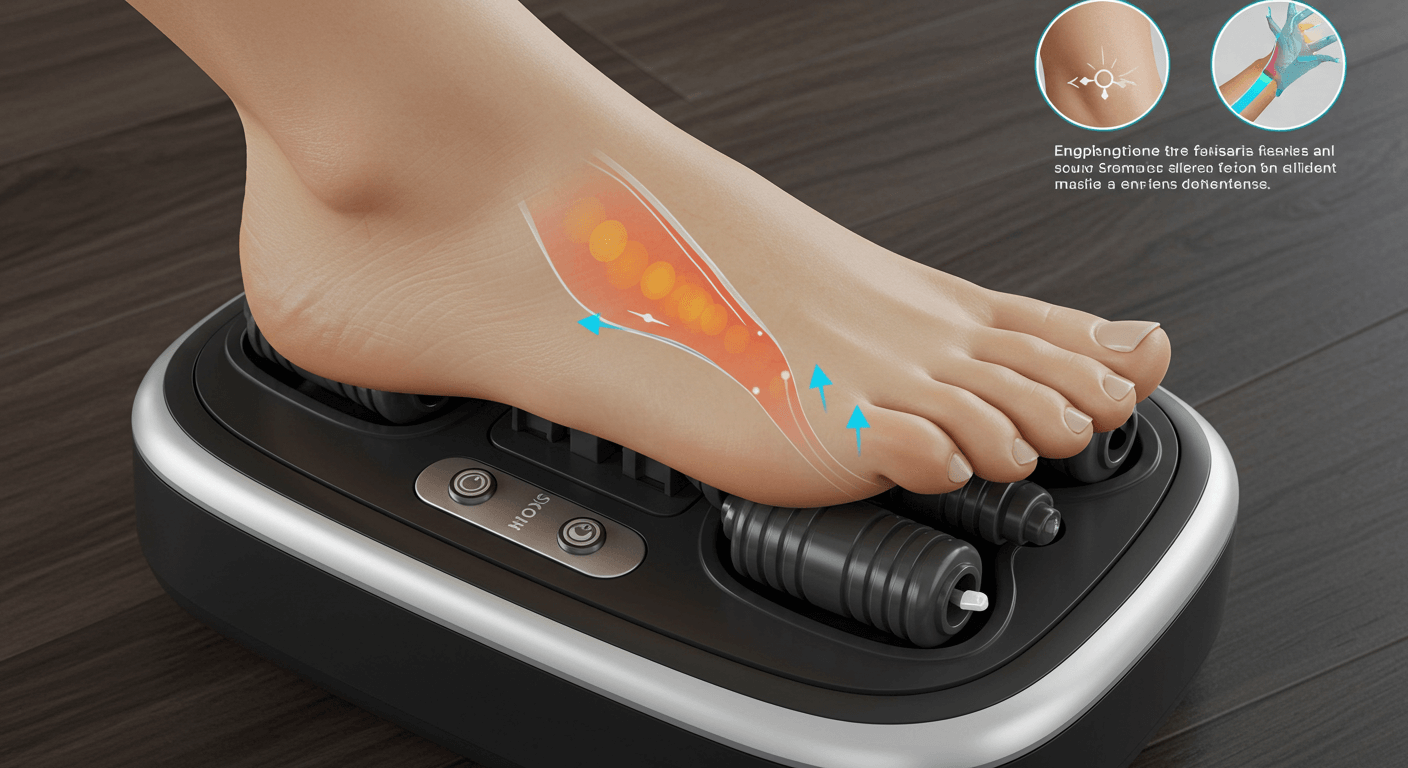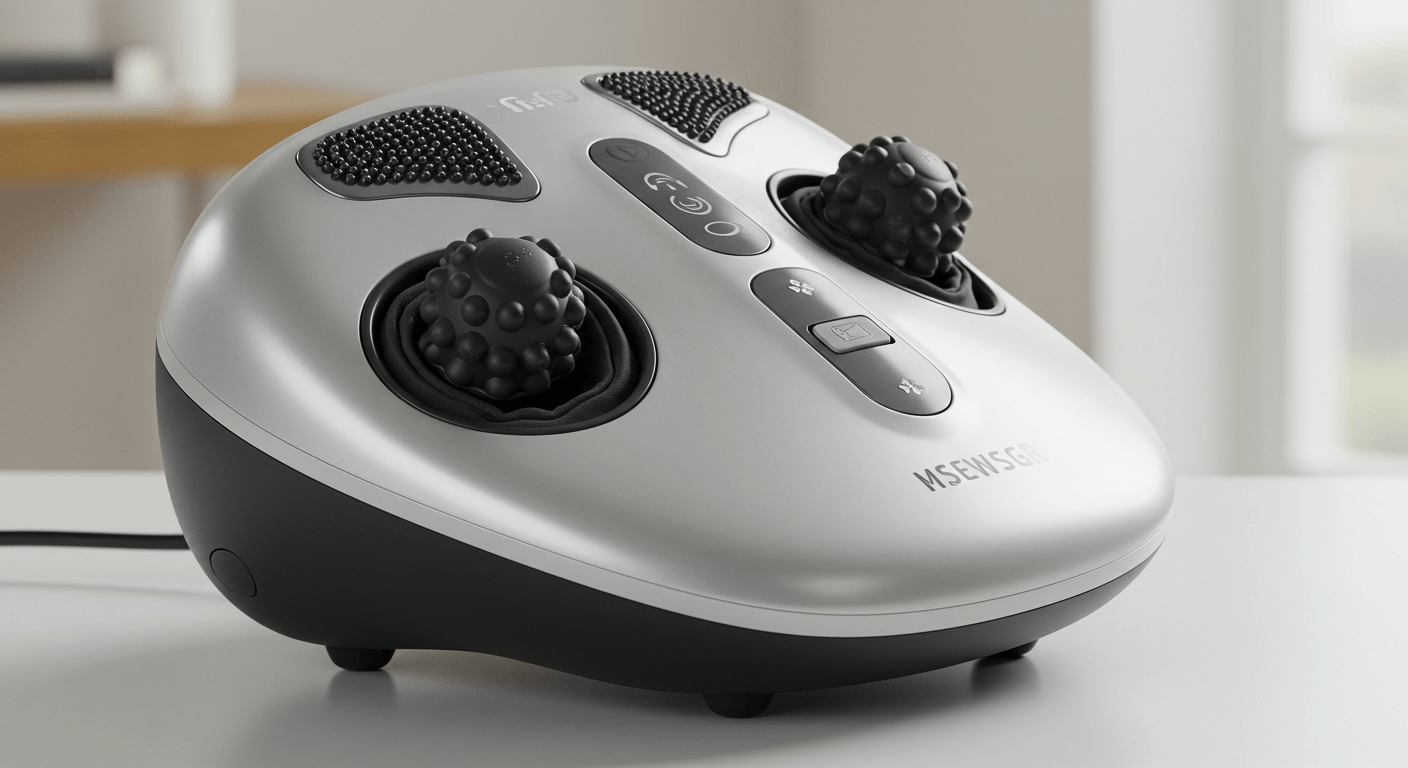Millions of people throughout the world suffer from plantar fasciitis, one of the most prevalent causes of heel discomfort. Stunting discomfort that is frequently worse in the morning or after extended standing is the result of inflammation of the plantar fascia, a thick band of tissue that connects the heel bone to the toes. Finding efficient alleviation techniques becomes crucial for those who are dealing with this ongoing agony.
Foot massagers are one option that is becoming more and more popular. By increasing circulation, lowering tension, and reducing inflammation, these tools—which range from hot compression devices to electric shiatsu massagers, promise to provide calming comfort. They are often used by persons with plantar fasciitis as an easy at-home therapy substitute for expensive procedures or frequent trips to the clinic. However, there is still a crucial question: do foot massagers actually help with plantar fasciitis discomfort, or do they only offer short-term respite?
The science and usefulness of foot massagers for treating plantar fasciitis are examined in greater detail in this article. We’ll go over how these gadgets function, the precise ways they could alleviate symptoms, and the drawbacks that users need to be mindful of. We’ll also contrast foot massagers with other popular therapies, including professional physical therapy, orthotic inserts, and stretching exercises.
This book will offer clear insights whether you are looking for complementary treatments, have persistent heel pain, or are just inquisitive about the function of massage in foot health. By the end, you’ll know more about whether foot massagers are a good investment for treating plantar fasciitis or if you’d be better off spending your money on alternative options.
How Foot Massagers Work
Foot massagers immediately address typical symptoms of plantar fasciitis by reducing muscular tightness, increasing circulation, and relieving tension. These devices target the plantar fascia, heel, and surrounding muscles by applying pressure and movement to the soles of the feet. This produces a calming effect that may help reduce pain and inflammation.
To provide relief, different kinds of foot massagers employ different methods. Shiatsu foot massagers work on trigger points and release tension in the fascia by simulating the kneading motions of a therapist’s hands. After periods of inactivity, vibration-based models promote blood flow, which aids in healing and lessens stiffness. Some devices use heat therapy, which relaxes tense tissues and improves circulation to the irritated area, adding an additional layer of relief.
A foot massager’s mechanical stimulation promotes better oxygen and nutrient delivery to the fascia, which can hasten the body’s inherent healing process. This results in less heel pain in the morning and less soreness after extended standing or walking for people with plantar fasciitis. By maintaining the fascia’s flexibility, regular use may aid in the management of recurrent discomfort.
Convenience is yet another advantage of foot massagers. A home gadget provides constant and instant access to relief, in contrast to in-person massage therapy, which necessitates visits and is more expensive. For many users, pain management can be significantly improved with just 10 to 20 minutes of usage each day.
It’s crucial to remember that foot massagers can reduce symptoms, but they cannot treat plantar fasciitis. Rather, they function best when incorporated into a larger strategy that also includes appropriate rest, supportive footwear, and stretching. They can be a useful tool for lowering pain and enhancing quality of life if used regularly.
Benefits of Using Foot Massagers for Plantar Fasciitis Relief

For those with plantar fasciitis, using a foot massager can provide a number of benefits, making it a useful tool for everyday relief. Pain relief is one of the main advantages. These gadgets’ mild kneading, vibrating, or rolling actions assist in releasing tense muscles, relaxing heel stiffness, and lessening the sharp pain that frequently occurs in the morning or after extended standing.
Better circulation is another significant advantage. The irritated fascia receives more oxygen and nutrients when blood flow to the foot rises. This lessens stiffness, aids in the healing process, and keeps the discomfort from getting worse over time. Improved circulation can help people with plantar fasciitis recover from activities more quickly and have less foot strain overall.
Heat treatment is another feature that many foot massagers include, which helps to further relax the surrounding muscles and fascia. Warmth reduces the chance of microtears by softening tissues and increasing their pliability. For those whose discomfort gets worse in cooler temperatures or after spending a lot of time on their feet, this can be especially beneficial.
Convenience is also another important benefit. With foot massagers, people can get relief at home without having to pay for pricey massage therapy appointments. It only takes a few minutes of regular application, usually only 10 to 20 minutes, to keep the fascia flexible and control recurrent pain.
Foot massagers may also aid in relaxation and stress reduction. Since physical stress and tension can exacerbate plantar fasciitis, encouraging general calm might help alleviate symptoms in an indirect manner.
Consistent use of foot massagers can help ease pain, promote healing, and enhance everyday comfort, but they are not a cure. Many patients find that these devices are a necessary component of a thorough therapy regimen that typically consists of rest, stretching, and supportive footwear.
Limitations and Risks of Foot Massagers for Plantar Fasciitis
Although plantar fasciitis can be effectively managed with foot massagers, it’s crucial to be aware of their drawbacks and possible hazards. Instead of being a stand-alone remedy, these gadgets ought to be considered a supportive therapy.
A significant drawback is that foot massagers don’t deal with the underlying cause of plantar fasciitis. Poor footwear, excessive use, or biomechanical problems like flat feet or high arches are some of the common causes of the ailment. Even with routine massage, problems may recur if these underlying causes are not addressed.
Temporary release is another restriction. Massage does not have long-lasting effects, although it may reduce heel pain and stiffness for a few hours. Foot massagers must be used in conjunction with stretching, physical therapy, and lifestyle modifications for long-term benefits.
Overuse carries additional dangers. Excessive pressure or prolonged use of a massager can aggravate the plantar fascia, increasing inflammation rather than decreasing it. Shorter sessions are best for people with sensitive feet, and usage should be increased gradually.
Some groups should exercise caution. Individuals with diabetes, neuropathy, or poor circulation may be at risk of injury since limited sensitivity in the feet can make it difficult to notice excessive pressure or heat. Likewise, unless authorized by a medical practitioner, anyone with open wounds, severe arthritis, or fractures should completely avoid using foot massagers.
Not all devices are created equal, which is another factor to take into account. Inconsistent pressure, painful rolling mechanics, or a lack of safety features are some of the ways that low-quality massagers can decrease their effectiveness and raise the possibility of discomfort.
Foot massagers work best when incorporated into a larger management strategy. They can be safe and beneficial when paired with appropriate footwear, stretching, and medical supervision. However, if safeguards aren’t followed, depending only on them could result in disappointment or worsened symptoms.
How to Use Foot Massagers Safely
Plantar fasciitis discomfort can be reduced by utilizing a foot massager, but in order to get the most out of it without being hurt, safety and good technique are crucial.
As your feet adjust, progressively extend the length of your sessions from brief ones, usually lasting 10 to 15 minutes. Moderation is essential since overuse or excessive pressure might irritate the plantar fascia. Always pay attention to your body, and if pain gets worse, quit.
On your device, select the appropriate setting. Numerous electric massagers have rolling movements, heat features, and intensity settings that may be adjusted. Starting with moderate to medium pressure is ideal for plantar fasciitis; excessively vigorous kneading could exacerbate irritation. Use the heat treatment feature cautiously at first to see whether it helps ease stiffness if the massager has it.
The proper placement of your feet is also crucial. To target sore places, place your heel and arch directly on the rollers or vibrating surface and move your foot slowly. Avoid applying all of your entire weight to the massager, as this may result in excessive pressure.
Results are improved when stretching exercises are combined with massage. To increase flexibility and lessen tightness, gently stretch the plantar fascia and calves after each practice. Massage therapy will be further enhanced by wearing orthotics or supportive shoes during the day.
It is advised that those with diabetes, neuropathy, or circulation issues speak with a healthcare professional before using a foot massager. If pressure or heat is applied too intensely, reduced foot sensation may raise the risk of damage.
Lastly, consistency is important. As part of a more comprehensive treatment strategy that also includes physical therapy, appropriate footwear, and rest, using a foot massager a few times a week can help effectively manage pain. Foot massagers can be a useful tool for aiding in the rehabilitation process from plantar fasciitis if used carefully and correctly.
Conclusion

The appropriate tools can make a big difference in a care routine, yet plantar fasciitis can be a difficult condition that interferes with everyday comfort and movement. When used properly and regularly, foot massagers can improve circulation, release tense muscles, and lessen pain in the arch and heel. Although they cannot treat plantar fasciitis, they can help with other tried-and-true methods like physical therapy, supportive shoes, and stretching.
The type of gadget, the intensity of symptoms, and the individual all have a significant impact on how effective a foot massager is. While some people may only perceive momentary respite, others may see considerable changes in their pain levels. Selecting a massager that meets your individual demands, offers firm yet gentle stimulation, and has adjustable intensity is crucial.
Seeking advice from a healthcare professional before to starting any new medication guarantees safe use, particularly if there are underlying medical disorders like diabetes or cardiovascular problems.
In the end, foot massagers can be a useful supplement to an all-encompassing treatment strategy for plantar fasciitis. They might aid in comfort restoration and facilitate everyday mobility when combined with regular foot care and good foot habits.
